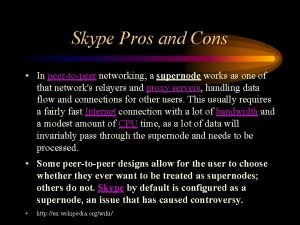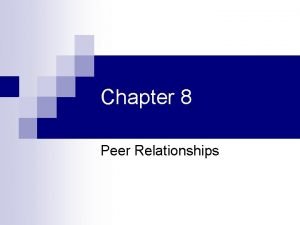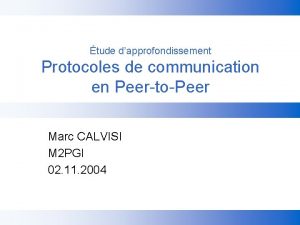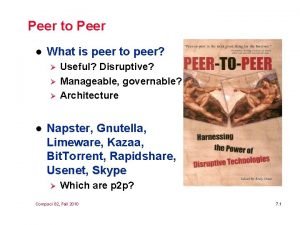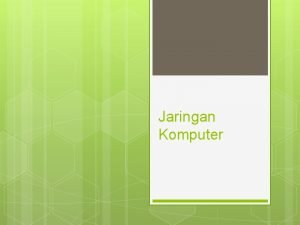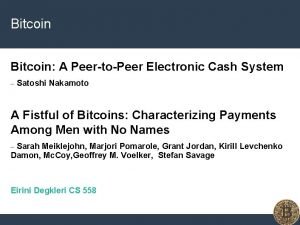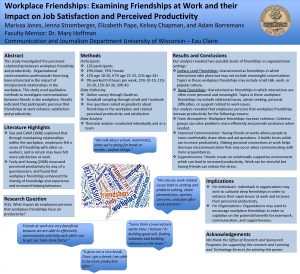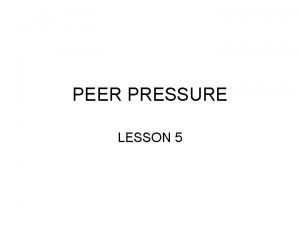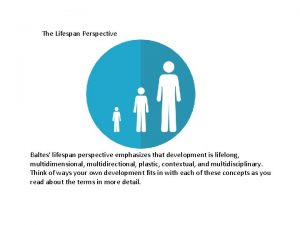Friendships that last Peer lifespan and its role
















- Slides: 16

Friendships that last Peer lifespan and its role in P 2 P protocols Fabián E. Bustamante & Yi Qiao Department of Computer Science Northwestern University {fabianb, yqiao}cs. northwestern. edu www. aqualab. cs. northwestern. edu

P 2 P and heterogeneity P 2 P computing: sharing of computer resources & services by direct exchange between participants Purest form … all peers are equal Problem: clash between assumption and reality - peer populations show high variations on storage, bandwidth, latency, degree of sharing, uptime, … Dept. of Computer Science Northwestern University 2

Transient peers and P 2 P systems Peers defined an overlay network – Set of connections to other peers (their “friends”) – Maintenance protocol that repairs the overlay Degree of peer transiency – Median up-time ~ 70’ – Implications 1. Maintenance-related messages 2. Plus degree of replication, effectiveness of caches, spread of queries, overall system scalability, … Dept. of Computer Science Northwestern University 3

Our approach Part of the problem is whom one befriends – One solution: pick those that will live/stay long Without knowing the future, can we predict it? – Yes; peer lifespan follows a Pareto distribution! Given a good prediction - how should it be used in P 2 P protocols? Can it really help? Dept. of Computer Science Northwestern University 4

Determining lifespan distribution In Gnutella, using a modified client, between March 1 st-8 th, 2003 Some details: – Attempt a Gnutella connection setup – 20 monitoring peers for fine probe granularity – First-time found peers only recorded with Time. When-Found – Peer considered dead when • Connection attempt fails 3 rd time • Unexpected response is received Dept. of Computer Science Northwestern University 5

Peer lifespan distribution 500, 000 peers, ~1 million peers’ lifespans Create-based method for sample limited scope Figures show RCDF of peers with lifespan in [1, 300 sec, 3. 5 days] Pareto distribution of the form λTk (k < 0) Dept. of Computer Science Northwestern University 6

Peer Lifespan and P 2 P protocols Choosing among “acquaintances”: – When deciding whom to befriend – Responding to requests for references In most P 2 P protocols – random selection Peer lifespan fits a Pareto distributions Є UBNE class (Used Better than New in Expectation) Peer’s expected remaining lifetime directly proportional to current age Dept. of Computer Science Northwestern University 7

Some of the questions … How could we incorporate lifespan-based ideas into P 2 P systems? Potential gains in reduced maintenance overhead Effects on application performance … Dept. of Computer Science Northwestern University 8

Lifespan-based protocols Increased dependency as commitment to the community becomes clear Protocol Connect? Recommend? LSPAN-1 Oldest Random LSPAN-2 Oldest LSPAN-3 Oldest & more available connections Random Dept. of Computer Science Northwestern University 9

Experimental setup Trace-driven simulation – P 2 P simulator includes membership management and various query distribution, cache and replication strategies Runs of one of the 20 collected traces for a period of 510, 000 sec. , ~36, 577 peers Cold start, warm-up ~80, 000 sec. excluded ~1, 000 peers under stable conditions Dept. of Computer Science Northwestern University 10

Alternative protocols compared Unstructured Decentralized Protocol (UDP) – ~ early Gnutella – Separate pools for cached pongs (per connection) – Pong replies include random set of entries from cache Hierarchical Decentralized Protocol (HDP) – ~ new Gnutella, Ka. Zaa – Leaf- and ultra-peers: leafs can only connect to ultras; ultras to anybody – To decide a peer’s role – trace information Dept. of Computer Science Northwestern University 11

Comparing connection breakdowns Indicator of stability √ Lifespan-based protocols More selective → fewer breakdowns Reductions – 42 -43% -LSPAN-2 – 26 -30% -LSPAN-1 and LSPAN-3 Saw-tooth shape → time -of-day patterns Dept. of Computer Science Northwestern University 12

Comparing connection rejections Does preference for long-lived peers have to mean high rejection rates? True for LSPAN-2 – although may be a reasonable “cost” Still, for LSPAN-1 and LSPAN-3 low enough to be ignored LSPAN -3 ~ 1/17. 58 hrs! Dept. of Computer Science Northwestern University 13

Comparing number of connections … not just rejections, what about number of connections? LSPAN-1 and LSPAN 3 – higher ratio of connections per peer Little benefit from checking available connections Dept. of Computer Science Northwestern University 14

A preview: Effects on applications Gains in scalability With random-walkers & NCU (Neighboring Caching) Lifespan-based: 5 and random topology: 16 walkers Dept. of Computer Science Northwestern University 15

Conclusions and future work Peer lifespan fits a Pareto distribution – current age to predict lifespan Illustrative lifespan-based protocols Advantages of considering peers’ age in P 2 P protocols Possible research paths – – Effect on query distribution and cache strategies Lifespan-based strategies Determining a peer’s age in decentralized P 2 P systems Lifespan and DHTs Dept. of Computer Science Northwestern University 16
 Features of peer to peer network and client server network
Features of peer to peer network and client server network Skype pros and cons
Skype pros and cons Chapter 8 lesson 1 safe and healthy friendships
Chapter 8 lesson 1 safe and healthy friendships Chapter 8 peer relationships
Chapter 8 peer relationships Chapter 8 lesson 1 safe and healthy friendships
Chapter 8 lesson 1 safe and healthy friendships Annotazioni sulla verifica effettuata peer to peer
Annotazioni sulla verifica effettuata peer to peer Peer-to-peer
Peer-to-peer Peer to peer transactional replication
Peer to peer transactional replication Peer to peer transactional replication
Peer to peer transactional replication Konsep dasar jaringan komputer
Konsep dasar jaringan komputer Esempi di peer to peer compilati
Esempi di peer to peer compilati Esempi di peer to peer compilati 2021
Esempi di peer to peer compilati 2021 Registro peer to peer compilato
Registro peer to peer compilato Peer to peer l
Peer to peer l Peer to peer merupakan jenis jaringan… *
Peer to peer merupakan jenis jaringan… * Bitcoin: a peer-to-peer electronic cash system
Bitcoin: a peer-to-peer electronic cash system Ambiti operativi da supportare
Ambiti operativi da supportare

